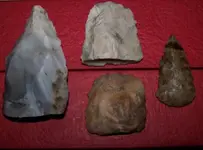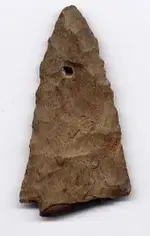Zeke said:
Real ones will have a patina on the surface of the rock/flint from being in the ground..... Fake ones wont. You can see this on ones found in a plowed field. If the plow hits it and breaks or chips the artifact, it will be shiny where the chip is and duller on the surface. Some rocks take on the patina better than others. Ones made of quartz dont. One way to see this is take a point you have found that is broke in half.......dont do it to a whole point!!!!......and chip it on the edge. Where you chip it will be a totally different color.
Also......it takes a very seasoned flintknapper to produce a good point. The nicer ones(real) will be symetrical and thin. I've seen alot of fakes that are thick and lopsided. And then again......I've saw some modern points that are thin, symetrical, and well made....just didnt have the patina on them.
You have to be careful nowdays as to what you buy. Some points can go into the 5 figure mark according to their age,type, kind of rock, and how well they are made. A good book to get is Overstreets Price Guide to Indian Arrowheads. Its put out yearly with tons of pics of about every different point known to exist....along with prices for different stages of condition. I havent gotten one in awhile but a Clovis point in excellent condition was priced at around 20,000 in a guide I have from the 90s.
While I agree on MOST of your points...some I don't. Most fake points you see are not lopsided and thick. Just the opposite. Most modern made points are very thin, and almost perfect in every way...the high end ones anyhow. On that note, not many people reproduce junk. The goal is to reproduce high grade pieces, usually the high dollar items....clovis points, dovetails, etc. they are usually always larger than the typical point of that type, and made of very high grade materials, etc. While most can't "fake" a patina...some people these days have been doing a pretty darn good job of it.
Anyhow, not many people are going to fake a $10-$15 lopsided, thick, crappy point.
Also, while I agree that by taking a broken point and flaking it, you can see the changes in the material, thus making it easier to compare...but there are so many variations of chert/flint, it's pretty hard to do this for a beginner. Take Flint Ridge for example....there are thousands of colors, lustres, textures, etc. I'd personally found ancient points in the field, that if I hadn't found, I'd almost think they were modren made based on the lustre and how fresh the flakes appeared to be....and I've got 15 years of collecting and archaeology under my belt.
Of course, with time, you begin to see patterns and it's pretty easy to spot most fakes...but there are many damn good knappers out there punching out the fakes....and some are pretty hard to tell!
My biggest disagreement with your post however is "Overstreets" book. It's complete garbage. That series is so full of modern/fake/replicated points it's disgusting. Completely useless for referenece material, and the prices are absurd, and nothing close to what you'd fetch at market.
 jd
jd jd
jd




